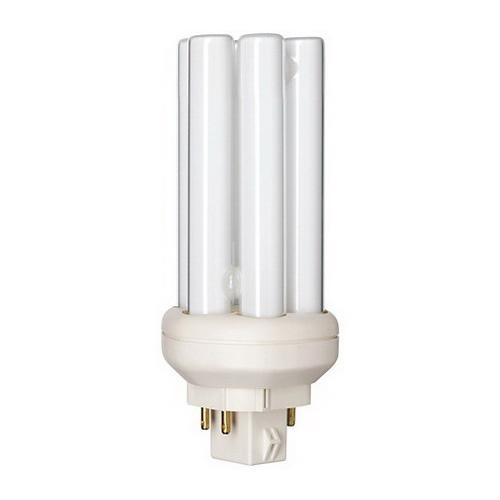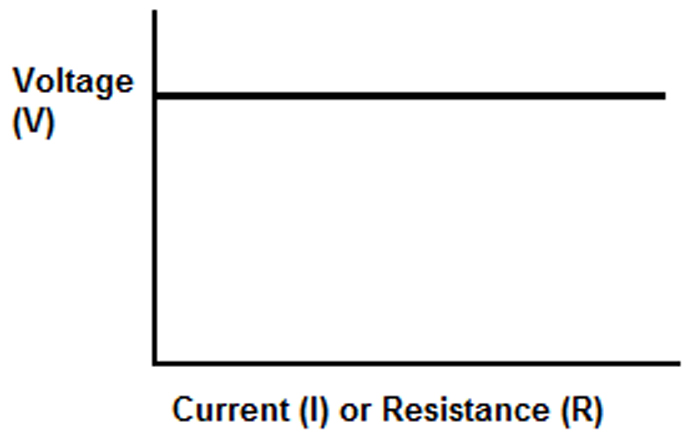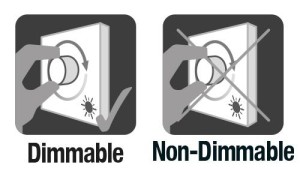There are a number of different designs of compact fluorescent lamps CFL on the market which can make it quite confusing to decide which is design is the best one to go for. Here we will look at the major types and review the advantages and disadvantages of these energy saving light bulbs.
Linear Tube CFL
The majority of the early CFL bulbs introduced in to the UK market were of the linear tube design as shown in the picture. . The linear CFL is just a long thin fluorescent tube which goes up vertically and then is looped back and this pattern can be repeated several times for high wattage light bulbs. These light bulbs are the cheapest to manufacturer and work well as an energy saving light bulb. The disadvantages of the linear CFL are two fold. Firstly, the look of the light bulb is rather cumbersome and quite odd certainly when compared to the traditional incandescent GLS bulb. It is not that the bulb is inherently gross from an aesthetic point of view but I think it is more the fact that the light bulb looks very different to what people generally expect a light bulb to look like and for this reason it is not rated highly from a visual perspective. The second issue is that because the design is thin and tall the bulbs are quite long in length and for this reason can be difficult to physically fit into a number of light fittings where there is a height restriction.
Semi Spiral CFL
 The semi spiral light bulb has always been fairly common in the US market and has recently been introduced to the UK. The design of the CFL is shown in this picture. Again the semi spiral CFL is simply a long thin fluorescent tube which is looped around in a spiral shape but the first portion of the fluorescent tube just goes up vertically. Accordingly the semi spiral name is derived because this CFL is half linear and half spiral and therfore designated as a semi spiral. The overall look of the bulb is more akin to the traditional bulb and because of the fact that the fluorescent tube swings outwards it has a larger diameter than the linear CFL and accordingly the overall height can be reduced and the bulb will still produce a similar level of lumens output.
The semi spiral light bulb has always been fairly common in the US market and has recently been introduced to the UK. The design of the CFL is shown in this picture. Again the semi spiral CFL is simply a long thin fluorescent tube which is looped around in a spiral shape but the first portion of the fluorescent tube just goes up vertically. Accordingly the semi spiral name is derived because this CFL is half linear and half spiral and therfore designated as a semi spiral. The overall look of the bulb is more akin to the traditional bulb and because of the fact that the fluorescent tube swings outwards it has a larger diameter than the linear CFL and accordingly the overall height can be reduced and the bulb will still produce a similar level of lumens output.
Full Spiral CFL
The final choice considered here is the full spiral CFL which is shown in this picture.
With the full spiral CFL the fluorescent tube spiral starts right at the base of the bulb and continues in a tight spiral to the top of the bulb. The benefits of this design is that because the spiral design is inherently more compact and because of the fact that the spiral starts lower, the overall dimensions of the bulb are less than the semi spiral CFL which gives it an overall more compact design. This is invariably important for the fitment into a number of closed light fittings or lanterns where there is a bulb height restriction. The aesthetic angle is clearly subjective and dependent on peoples individual views but I think that the compact proportions and shaping of the full spiral CFL make its looks more appealing than the semi spiral of linear CFL.
So from our perspective the Full Spiral CFL is the clear winner.
Source (Copyright © 2018 Saving Light Bulbs) — https://www.saving-light-bulbs.co.uk/blog/cfl-choice-full-or-semi-spiral-or-linear/
Linear Tube CFL
The majority of the early CFL bulbs introduced in to the UK market were of the linear tube design as shown in the picture. . The linear CFL is just a long thin fluorescent tube which goes up vertically and then is looped back and this pattern can be repeated several times for high wattage light bulbs. These light bulbs are the cheapest to manufacturer and work well as an energy saving light bulb. The disadvantages of the linear CFL are two fold. Firstly, the look of the light bulb is rather cumbersome and quite odd certainly when compared to the traditional incandescent GLS bulb. It is not that the bulb is inherently gross from an aesthetic point of view but I think it is more the fact that the light bulb looks very different to what people generally expect a light bulb to look like and for this reason it is not rated highly from a visual perspective. The second issue is that because the design is thin and tall the bulbs are quite long in length and for this reason can be difficult to physically fit into a number of light fittings where there is a height restriction.
Semi Spiral CFL
 The semi spiral light bulb has always been fairly common in the US market and has recently been introduced to the UK. The design of the CFL is shown in this picture. Again the semi spiral CFL is simply a long thin fluorescent tube which is looped around in a spiral shape but the first portion of the fluorescent tube just goes up vertically. Accordingly the semi spiral name is derived because this CFL is half linear and half spiral and therfore designated as a semi spiral. The overall look of the bulb is more akin to the traditional bulb and because of the fact that the fluorescent tube swings outwards it has a larger diameter than the linear CFL and accordingly the overall height can be reduced and the bulb will still produce a similar level of lumens output.
The semi spiral light bulb has always been fairly common in the US market and has recently been introduced to the UK. The design of the CFL is shown in this picture. Again the semi spiral CFL is simply a long thin fluorescent tube which is looped around in a spiral shape but the first portion of the fluorescent tube just goes up vertically. Accordingly the semi spiral name is derived because this CFL is half linear and half spiral and therfore designated as a semi spiral. The overall look of the bulb is more akin to the traditional bulb and because of the fact that the fluorescent tube swings outwards it has a larger diameter than the linear CFL and accordingly the overall height can be reduced and the bulb will still produce a similar level of lumens output.Full Spiral CFL
The final choice considered here is the full spiral CFL which is shown in this picture.
With the full spiral CFL the fluorescent tube spiral starts right at the base of the bulb and continues in a tight spiral to the top of the bulb. The benefits of this design is that because the spiral design is inherently more compact and because of the fact that the spiral starts lower, the overall dimensions of the bulb are less than the semi spiral CFL which gives it an overall more compact design. This is invariably important for the fitment into a number of closed light fittings or lanterns where there is a bulb height restriction. The aesthetic angle is clearly subjective and dependent on peoples individual views but I think that the compact proportions and shaping of the full spiral CFL make its looks more appealing than the semi spiral of linear CFL.
So from our perspective the Full Spiral CFL is the clear winner.
Click below to buy from our wide range of energy efficient CFL Lights
Source (Copyright © 2018 Saving Light Bulbs) — https://www.saving-light-bulbs.co.uk/blog/cfl-choice-full-or-semi-spiral-or-linear/



















.png?format=1500w)



